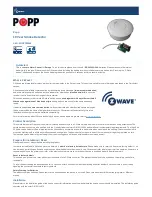
The first step is to mount the mounting base on the desired place in the home using screws.
Remove the battery isolation strip from the wireless module. The red LED will start blinking.
Include the Smoke Sensor into your existing Z-Wave based Smart Home Network using the Z-Wave button.
Place the Smoke Detector on the mounting base and turn clockwise. Now the Smoke Detector is armed.
Battery Change: The battery of the wireless module will be empty much earlier than the 10 years soldered in battery of the smoke sensor. To replace
the battery, remove the Smoke Detector, pull off the wireless module from the smoke sensor. Then you can replace the 1/2 AA battery and replug
the wireless module.
Inclusion/Exclusion
On factory default the device does not belong to any Z-Wave network. The device needs to be added to an existing wireless network to communicate
with the devices of this network. This process is called Inclusion.
Devices can also be removed from a network. This process is called Exclusion. Both processes are initiated by the primary controller of the Z-Wave
network. This controller is turned into exclusion respective inclusion mode. Inclusion and Exclusion is then performed doing a special manual action right
on the device.
Inclusion
Secure Inclusion: Push the button for 3 seconds
Unsecure Inclusion: Push the button for 1 seconds
Exclusion
Push the button for 1 second
Product Usage
In case smoke is detected by the smoke detector the device will sound and the wireless module will issue a Z-Wave alarm command to the main controller
and BASIC commands other associated devices. The value of the BASIC message is defined in Configuration Parameter 3 and 4. The device will report
the battery level of the module but not the level of the built-in battery of the detector head. Once the device is placed on the mounting plate the tamper
protection is active. Whenever the smoke detector head will be removed from the base for more then 4 seconds an tamper alarm will be sent wirelessly to
the main controller. Note: All communication of the wireless module is performed with application level security if the device was included securely and all
communication partners support secure communication as well. In case a non-secure device is associated for switching on smoke alarm (in association
group 2), the smoke detector will detect this and change the communication style to non-secure for this very device only. This process happens one time
and will take about 20 seconds. This delay will happen on first communication only.
Alarm Messages
The device will issue the following (unsolicited) alarm messages:
Smoke Detected (this alarm message will be issued as well when the test button is pressed)
Low Battery Alarm (when the battery of the wireless modules goes low), indicated by red LED
Tamper Detected (ON, when the smoke detector head is removed from the base; OFF, when the detector head is mounted to the base)
End of Life (issued, when the Detector Main Head has reached its end of life after 10+ years.)
Node Information Frame
The Node Information Frame (NIF) is the business card of a Z-Wave device. It contains information about the device type and the technical capabilities.
The inclusion and exclusion of the device is confirmed by sending out a Node Information Frame. Beside this it may be needed for certain network
operations to send out a Node Information Frame. To issue a NIF execute the following action: A single click on the Z-Wave sends out a NIF.




